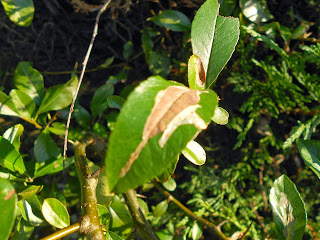A chill must have gripped my readers' hearts when, in my last blog, I mentioned that I was considering checking out the mosses and liverworts of the Byfield area. But putting such thoughts aside I sallied forth a couple of days ago to renew my contact with these much-neglected plants.
 |
Blue Roundhead, Stropharia caerulea?
Flower bed in Byfield. 8 November, 2013 |
In fact, the first organism to catch my attention as I passed the village hall was not a moss or a liverwort. Not a plant at all but a fungus. With a cap only 20 mm across it would have been easy to overlook it but its pale blue colour, glistening with slime made it stand out among some dark wood chippings. I am not a mycologist and therefore cannot be confident in my identification but, if it is not Blue Roundhead (Stropharia caerulea), it is certainly one of its close relatives.
I pressed on and after an hour or so had recorded half a dozen mosses and liverworts, all very common. On a fence post in the Pocket Park was Common Pincushion Moss (Dicranoweisia cirrata).
 |
Common Pincushion, Dicranoweisia cirrata. Byfield Pocket Park
8 November, 2013 |
Each moss species tends to favour a particular substrate - acid rock, alkaline rock, tree bark, bare soil and so on. A weathering fence post such as the one shown is a typical habitat for Common Pincushion.
Adjacent to the Pocket Park is a burial ground. Large areas of the "turf" were composed more of moss than grass, the culprit being Springy Turf-moss, Rhytiadelphus squarrosus. It is indeed very springy and pleasant to walk on - but try telling that to a gardener whose lawns are infested with it. It is a beautiful moss too under a microscope, a feature to which my photograph fails to do justice.
 |
Springy Turf-moss, Rhytiadelphus squarrosus
Byfield burial ground, 8 November, 2013 |
My final call was the churchyard. (Come to think of it, its the final call for many of us.) Again, very commonplace mosses were present until, on a damp shady section of wall I saw something rather different. "Ah," I said to myself. "That looks like a Pouncewort." (Don't tell porkies. Admit you didn't have a clue!) O.K. other than recognising it as a liverwort, I really didn't know. Once home, a bit of investigation with Watson (that's E.V.Watson*, not Sherlock Holmes' sidekick) I keyed it out as Lejeunea cavifolia. Latin names are often a bit of a mouthful but the common name is Micheli's Least Pouncewort. For once the Latin name seems simpler.
 |
Micheli's Least Pouncewort, Lejeunea cavifolia.
On wall, Byfield churchyard. 8, November, 2013 |
This liverwort is largely confined in Britain to Wales and the west country. It is only known from a handful of sites in Northamptonshire so I was smugly satisfied with my find.
Once home, I paid attention to the porch over our own front door. It is constructed using a fissile limestone akin to Collyweston Slate and is a congenial home for many mosses. The most abundant of these proved to be Grey-cushioned Grimmia, Grimmia pulvinata, instantly recognisable from the way its setae (fruiting capsules) are curved over to bury their heads among the leaves. Long, whiskery leaf tips give it a greyish appearance.
I finally strolled around my back garden
 |
Overhanging porch with a rich growth of mosses.
Byfield, 8 November, 2013 |
in search of Common Pocket-moss. It is unusual in appearance, looking like a minute fern. Very common, I have found it in many gardens growing on damp, bare soil and again I was not to be disappointed. The area in which I found it is constantly disturbed by weeding, hoeing and so on. It looks delicate but it is a tough little plant and survives against the odds.
 |
Common Pocket-moss Fissidens taxifolius in my own garden
8 November, 2013 |
POSTSCRIPT
I was uneasy about the 'Pouncewort' so I sent a sample to Rachel Carter, the county bryophyte recorder. She identified it as a considerably commoner but close relative, Porella platyphylla, known as Wall Scalewort.
* E.V.Watson, "British Mosses and Liverworts". First published in 1955 it is, with numerous revised editions, still perhaps the best introductory book on the subject.
























